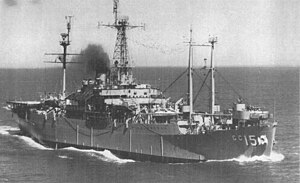
The third USS Austin (LPD-4) was the lead ship of her class of amphibious transport dock ships in the United States Navy. Austin was named in honor of the city of Austin, Texas which in turn was named in honor of Stephen F. Austin, a Texian patriot during the Texas War for Independence and the first Secretary of State of the Republic of Texas.

The second USS La Salle (LPD-3/AGF-3) was built as a Raleigh-class amphibious transport dock and entered service with the United States Navy in 1964. La Salle was named for the city in Illinois that was in turn named after René-Robert Cavelier, Sieur de La Salle. La Salle saw service in the Caribbean Sea, Gulf of Mexico and throughout international waters in the Middle East. The vessel served as a command ship for Joint Task Force Middle East. In 2005 the ship was decommissioned and sunk as a target ship off the Atlantic coast of the United States in 2007.

USS Trenton (LPD-14), an Austin-class amphibious transport dock, was the third ship of the United States Navy to be named for the capital of New Jersey. In 2007, it was sold to the Indian Navy and renamed INS Jalashwa.

USS America (CVA/CV-66) was one of three Kitty Hawk-class supercarriers built for the United States Navy in the 1960s. Commissioned in 1965, she spent most of her career in the Atlantic and Mediterranean, but did make three Pacific deployments serving in the Vietnam War. She also served in the Persian Gulf War's operations Desert Shield and Desert Storm.

USS Arthur W. Radford (DD-968) was a Spruance-class destroyer in the United States Navy. She was named for Admiral Arthur W. Radford USN (1896–1973), the first naval officer to be Chairman of the Joint Chiefs of Staff.

United States Naval Forces Europe-Africa (CNE-CNA), is the United States Navy component command of the United States European Command and United States Africa Command. Prior to 2020, CNE-CNA was previously referred to as United States Naval Forces Europe – Naval Forces Africa (NAVEUR-NAVAF).

USS Coontz (DLG-9/DDG-40) was a Farragut-class destroyer leader/frigate in the United States Navy. She was named after Admiral Robert Coontz, the US Navy's second chief of naval operations.
USS York County (LST-1175) was a De Soto County-class tank landing ship built for the United States Navy during the late 1950s. The lead ship of her class of seven, she was named after counties in Maine, Nebraska, Pennsylvania, South Carolina, and Virginia, she was the only U.S. Naval vessel to bear the name.

USS Mount McKinley (AGC-7/LCC-7) was the lead ship of the Mount McKinley class of amphibious force command ships. She was named after the highest mountain in North America. She was designed as an amphibious force flagship, a floating command post with advanced communications equipment and extensive combat information spaces to be used by the amphibious forces commander and landing force commander during large-scale operations.

USS Mount Olympus (AGC-8) was a Mount McKinley-class amphibious force command ship, named for the highest peak in the Olympic Mountains of the State of Washington. She was designed to be an amphibious forces flagship—a floating command post with advanced communications equipment and extensive combat information spaces to be used by the amphibious forces commander and landing force commander during large-scale operations.

USS Pocono (AGC-16) was an Adirondack-class amphibious force command ship named after a range of mountains in Eastern Pennsylvania. She was designed as an amphibious force flagship, a floating command post with advanced communications equipment and extensive combat information spaces to be used by the amphibious forces commander and landing force commander during large-scale operations.

USS Taconic (AGC-17/LCC-17) was an Adirondack class amphibious force command ship of the U.S. Navy named after the Taconic Mountains in New York. She was laid down in December 1944 and decommissioned in January 1969.

USS Wood County (LST-1178) was a De Soto County-class tank landing ship built for the United States Navy during the late 1950s. Named after counties in Ohio, Texas, West Virginia, and Wisconsin, she was the only U.S. Naval vessel to bear the name.
USS Terrebonne Parish (LST-1156), originally USS LST-1156, affectionately nicknamed the "T-Bone" by her early crew, was a Terrebonne Parish-class tank landing ship built for the United States Navy in 1952. The lead ship in her class, she was named for Terrebonne Parish, Louisiana, the only U.S. Navy vessel to bear the name. The ship was later transferred to Spain and renamed Velasco (L-11), and was scrapped in 1994.

USS Avenge (MSO-423) was an Agile-class minesweeper acquired by the U.S. Navy for the task of clearing mines that had been placed in the water to prevent the safe passage of ships.

USS Barnstable County (LST-1197) was the nineteenth ship of the Newport class of tank landing ships. She was laid down on 19 December 1970 at San Diego, California, by the National Steel and Shipbuilding Corporation and launched on 2 October 1971. She was commissioned on 27 May 1972. The ship was named after Barnstable County, Massachusetts.

USS Walworth County (LST-1164), previously USS LST-1164, was a United States Navy landing ship tank (LST) in commission from 1953 to 1971, and which then saw non-commissioned Military Sealift Command service as USNS Walworth County (T-LST-1164) from 1972 to 1973.

USS Waldo County (LST-1163), previously USS LST-1163, was a United States Navy landing ship tank (LST) in commission from 1953 to 1970, and which then saw non-commissioned Military Sealift Command service as USNS Waldo County (T-LST-1163) from 1972 to 1973.

USS Bassett (APD-73), ex-DE-672, was a United States Navy high-speed transport in commission from 1945 to 1946 and from 1950 to 1957.

USS Gherardi (DD-637/DMS-30), a Gleaves-class destroyer, is the only ship of the United States Navy to be named for Rear Admiral Bancroft Gherardi.


















